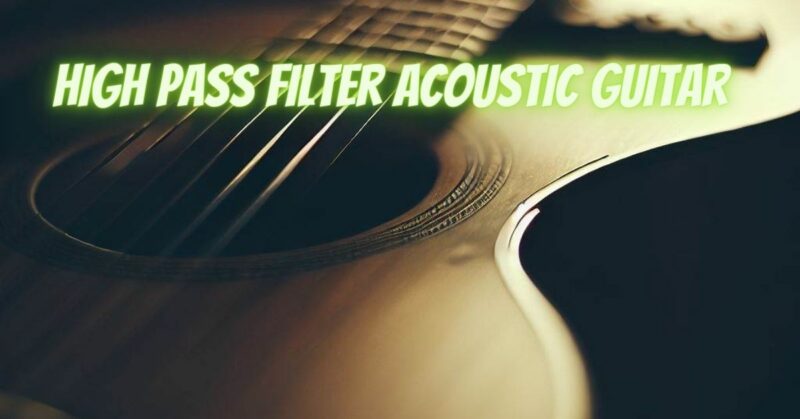High-pass filters are invaluable tools in the world of audio engineering, especially when it comes to acoustic guitar. These filters can be used to sculpt the sound, enhance clarity, and manage unwanted low-frequency elements that can muddy the mix. In this article, we’ll delve into the concept of high-pass filters and how they can be effectively utilized to bring out the best in your acoustic guitar sound.
Understanding High-Pass Filters
A high-pass filter (HPF) is an audio processing tool that allows frequencies above a specified cutoff point to pass through while attenuating frequencies below that point. In essence, it “filters out” or reduces the lower frequencies, emphasizing the higher frequencies. HPFs are particularly useful for eliminating rumble, stage noise, and other low-frequency artifacts that can interfere with the clarity of an acoustic guitar’s sound.
Benefits for Acoustic Guitar
Applying a high-pass filter to your acoustic guitar sound can have several benefits:
- Reducing Muddiness: Acoustic guitars can generate low-frequency vibrations from handling, body contact, or mechanical noises. These low-frequency components can make the sound muddy. An HPF helps remove these unwanted rumbling sounds, leaving room for the more essential aspects of your guitar’s sound to shine.
- Enhancing Clarity: By eliminating the low-frequency “junk,” an HPF allows the fundamental tones and harmonic content of your guitar to come through more clearly. This can be especially useful when performing with other instruments, as it prevents the acoustic guitar from competing with bass instruments in the low-end spectrum.
- Feedback Control: Removing unnecessary low frequencies can also contribute to feedback control, as feedback is often more prominent in the lower frequency range. An HPF can help minimize the chances of feedback occurring during a live performance.
Applying a High-Pass Filter
When applying a high-pass filter to your acoustic guitar sound, consider the following steps:
- Determine the Cutoff Frequency: The cutoff frequency is the point at which the filter begins to attenuate frequencies. Start with a conservative setting, usually around 80 Hz, and adjust from there based on your guitar’s characteristics and the mix.
- Use a Gentle Slope: High-pass filters often come with selectable slopes, measured in decibels per octave (dB/oct). A gentle slope of 12 dB/oct is a good starting point, gradually allowing frequencies above the cutoff to pass through.
- Monitor the Sound: Apply the high-pass filter and listen to your acoustic guitar sound. Notice how the removal of low-frequency components affects the clarity and overall tonal balance.
- A/B Comparison: Switch the high-pass filter on and off to hear the difference. This will help you determine if the filter enhances the sound without sacrificing essential tonal qualities.
- Adjust as Needed: Fine-tune the cutoff frequency and slope based on your acoustic guitar, the performance context, and any potential issues you’re addressing.
The use of a high-pass filter for acoustic guitar is a powerful technique that enhances clarity, reduces muddiness, and contributes to a cleaner mix. By selectively removing unwanted low-frequency elements, you allow the true character of your acoustic guitar to shine through with brilliance and articulation. Whether in a live performance or a studio recording, incorporating high-pass filters as part of your audio toolkit can significantly elevate the sonic quality of your acoustic guitar sound.

